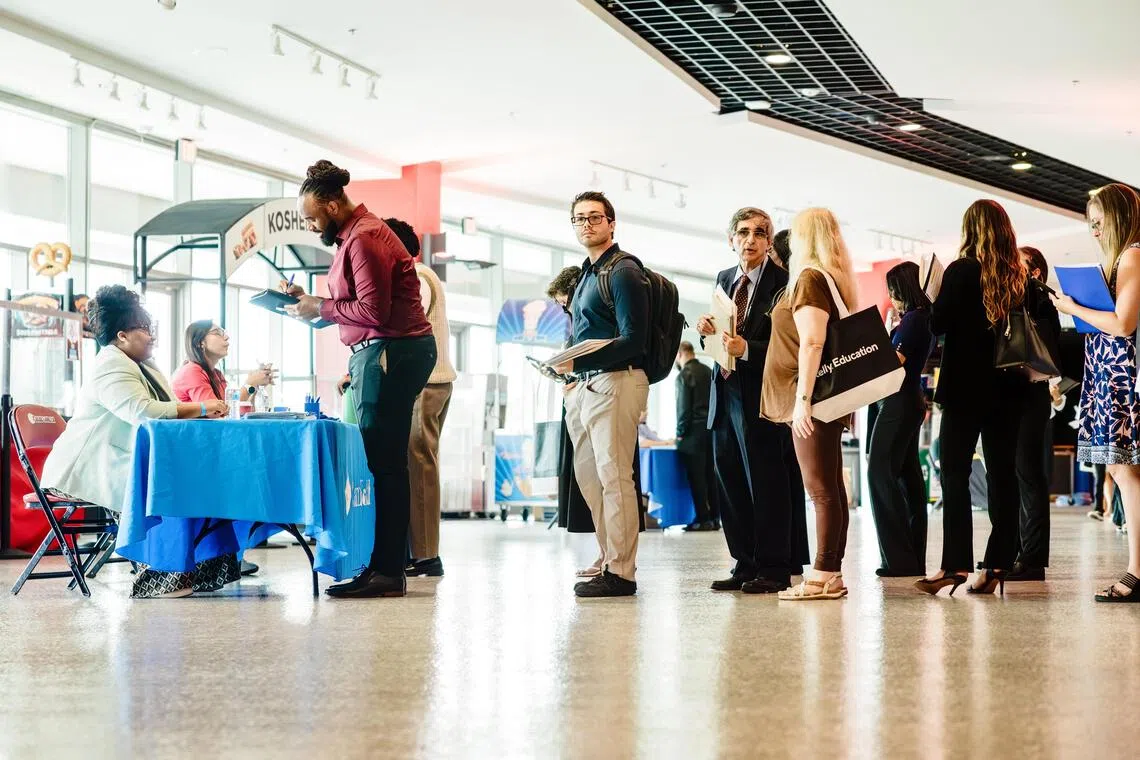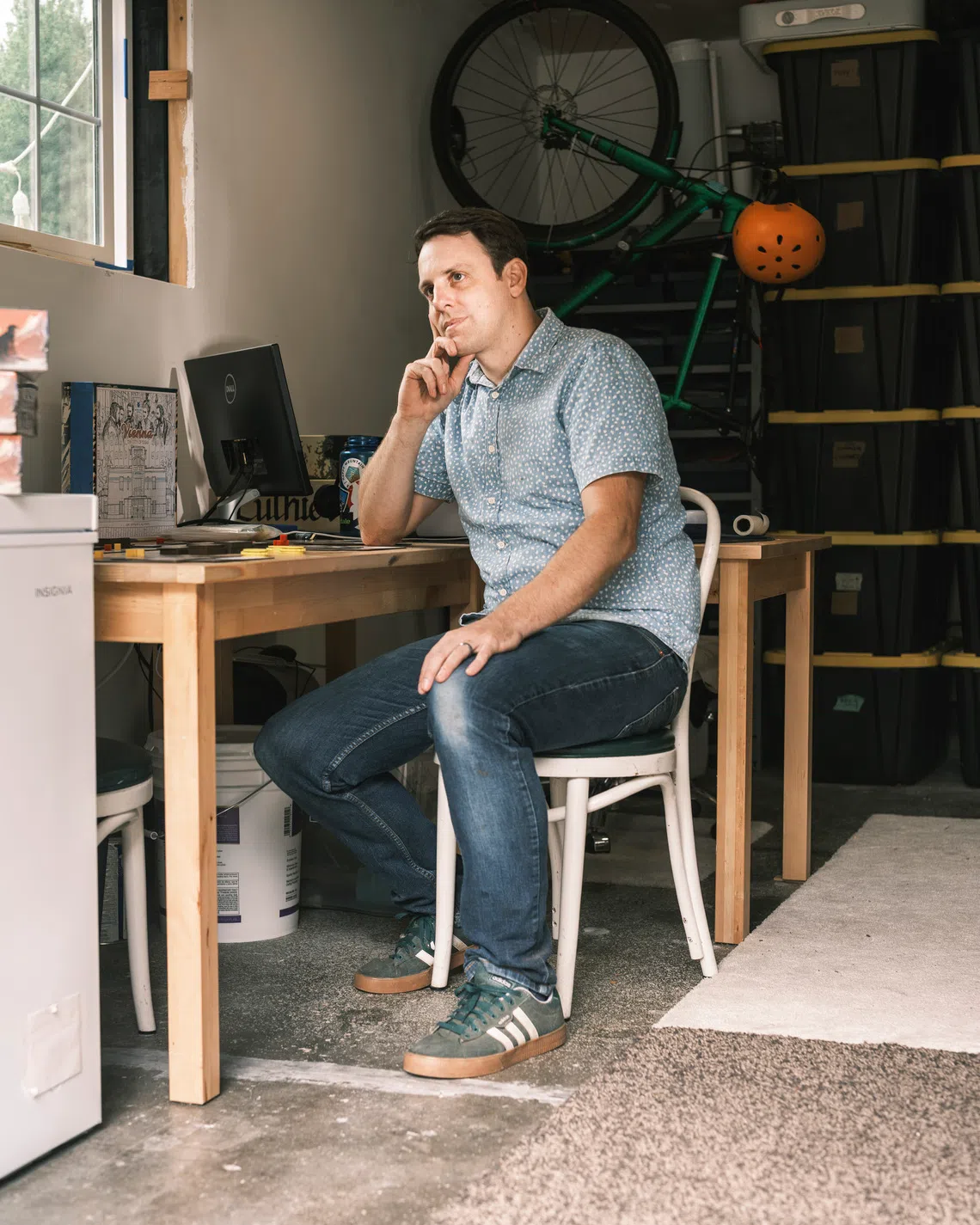Newest face of long-term unemployed in US? The college educated
Sign up now: Get ST's newsletters delivered to your inbox

August data showed the portion of unemployed people who have been out of work for more than six months rose to nearly 26 per cent in the US.
PHOTO: SCOTT MCINTYRE/NYTIMES
Noam Scheiber
Follow topic:
NEW YORK – Mr Sean Wittmeyer would seem to be highly employable. He has more than a decade of experience in architecture and product design, impressive coding chops and two master’s degrees. His skills make him an asset in two industries – technology and construction, which helped power the economy’s growth over the last 15 years.
But construction activity has faltered since 2023, after the Federal Reserve began raising interest rates, and many tech companies started layoffs around the same time.
That helps explain why the 37-year-old has been unemployed for 1½ years since he lost his job in business development for a company that makes software to help with real estate projects. He has been so eager to earn income that he has applied for positions befitting an intern, only to be told he was overqualified.
“I can’t even work at the little board game store down the street,” he said.
When the US government released its August employment numbers on Sept 5, the overall unemployment rate was still relatively low, at just more than 4 per cent.
But underneath was a concerning statistic: The share of unemployed people who have been out of work for more than six months, which is considered “long term”, rose to its highest level in over three years – to nearly 26 per cent.
The trend has alarmed some job-market watchers.
“Such an increase is unprecedented outside of recessions,” said an economist at the Federal Reserve Bank of Richmond, alluding to a steady worsening of the long-term unemployment rate.
Economists at Goldman Sachs recently expressed concern that a collapse in the number of job openings “risks locking out” those who are already unemployed.
But just as surprising as the rise in long-term unemployment is the subset of workers who are increasingly driving it: the college educated.
The fraction of long-term unemployed people with a college degree has grown from about one-fifth a decade ago to about one-third today, according to government data compiled by Professor Matthew Notowidigdo and Mr Jingzhou Huang of the University of Chicago. The problem has worsened over the past year or two, after easing temporarily.
Economists cite a number of reasons for this trend. There are simply more college graduates today than there were 10 years ago, and the job market for people without college degrees has improved, reducing their share of long-term unemployed.
But employers also appear to have less need for college-educated workers, driven by technological change, automation and, most recently, US President Donald Trump’s cuts to federal workers and funding, which have disproportionately affected the college educated.
“The data is signalling that there’s some restructuring going on,” said Professor Andreas Mueller, an expert on long-term unemployment at the University of Zurich.
“People are losing jobs and can’t find jobs in high-skilled occupations.”

Mr Sean Wittmeyer has two master’s degrees and is skilled in two industries, but he has been looking for work for 1½ years.
PHOTO: JORDAN GALE/NYTIMES
Any bout of unemployment can be traumatic, but the psychological and financial toll of long-term joblessness tends to be especially serious. More than 200 people responded to a New York Times questionnaire about being unemployed for longer than six months, and many mentioned depression or anxiety. A few alluded to thoughts of suicide.
“I have checked all the boxes of ‘success’ my entire life: went to college, got a degree (and) worked towards a career,” wrote Ms Katie Gallagher, a former sales and marketing director in Portland, Oregon. She has been out of work for almost a year and estimated that she had applied to more than 3,000 jobs.
“The stress of rejection is unbearable, along with the looming threat of financial insecurity,” the 34-year-old continued. “I have never felt depression like this before in my life.”
In an interview, Ms Gallagher said she had US$6,000 (S$7,700) in credit card debt and was relying on supplemental nutrition assistance. She said she recently borrowed about US$4,000 from her brother to enrol in a course on artificial intelligence (AI) automation and started a business that helps other firms automate functions such as sales and onboarding customers.
Employers’ need for college-educated workers appears to have slowed during the past decade or two, according to several studies by economists.
Even before ChatGPT was released, applications such as accounting software and earlier forms of AI used in fields such as finance and merchandise planning rendered some skilled workers obsolete.
Data from Indeed, the job-seeking platform, shows that the portion of job advertisements requiring a college degree has dropped about 6 per cent since 2019.
“There were big advances in AI starting around 2016,” said Professor Lawrence Katz, a labour economist at Harvard University.
The rapid development of AI has only accelerated the trend.
Mr Wittmeyer, who also lives in Portland, said the coding projects he once did – such as creating a tool that calculates the optimal window sizes for a facade – can often be done by someone far less skilled than he is.
“Anyone with a free subscription to Claude or ChatGPT could do a decent amount of what I could do before,” he said.
Prof Mueller, the expert on long-term unemployment, said college-educated workers may have more trouble finding jobs in a shrinking industry than workers without a degree because they are more likely to have skills or connections that are unique to that field. They may also be prone to excessive optimism and slow to realise that some of their traditional jobs are vanishing.
“You find yourself in a situation where you think, ‘I should have accepted that job earlier,’” he said. “That mechanism could be strong in a market where you have this restructuring and people have to switch from one sector to another.”
Mr Jeremey Davis – who was laid off as a senior director of engineering at Nielsen, the audience measurement firm – was offered a job early in his search, but turned it down because he was interviewing for another that he preferred.
Roughly 11 months, 1,200 applications and 17 interviews after losing his job, he is still out of work. “I rolled the dice, and they didn’t offer me the other position,” he said.
He said the number of applicants for each job has increased now that it is so easy to apply online, and he worries that it has become harder for job candidates to stand out.
Assistant Professor Emma Wiles, an expert on the use of algorithms in hiring at Boston University, said AI and other software tools can make the hiring process more random by creating a flood of similar-looking applications. That could hurt college-educated workers, who may have been less likely to get overlooked beforehand.
Mr Wittmeyer has also chafed against what he sees as an explosion of applications on sites such as LinkedIn. He has sent out more than 200 applications and heard back from only seven companies. NYTIMES

